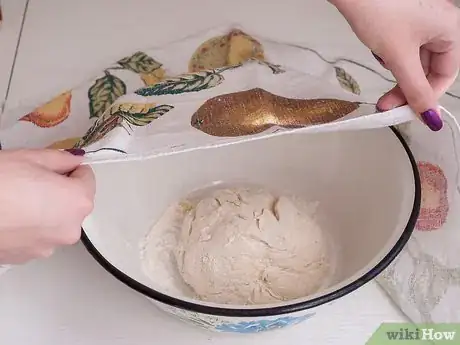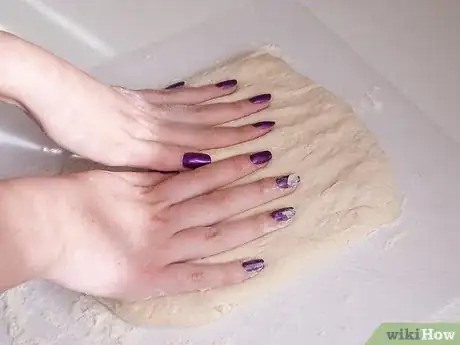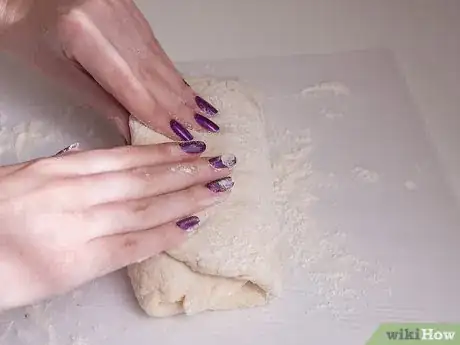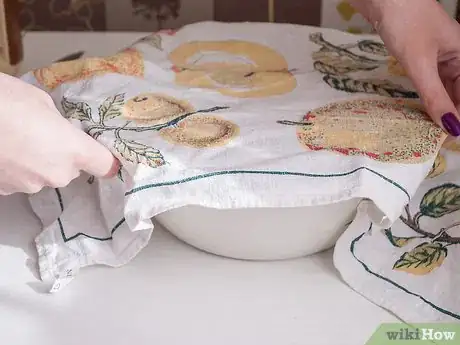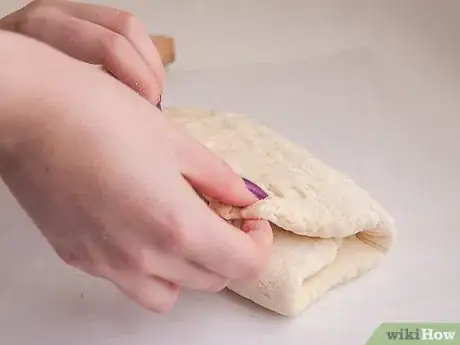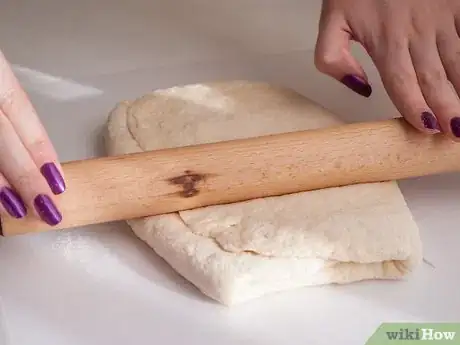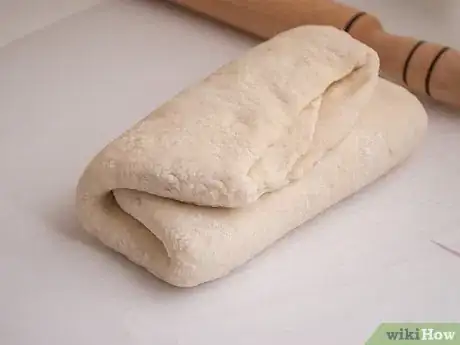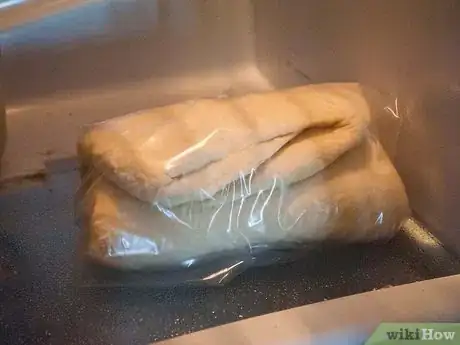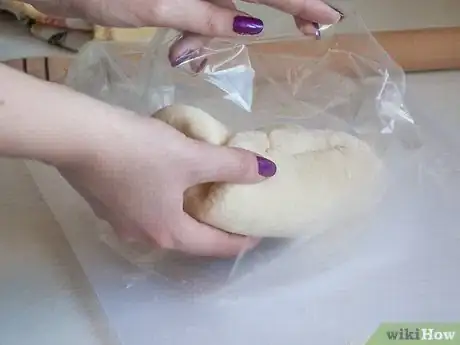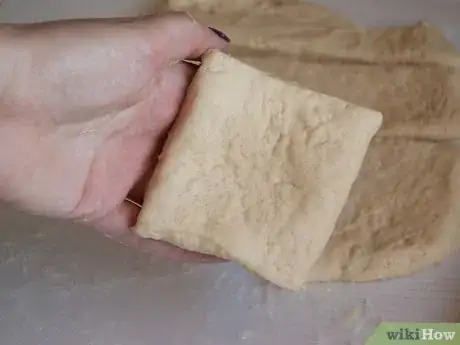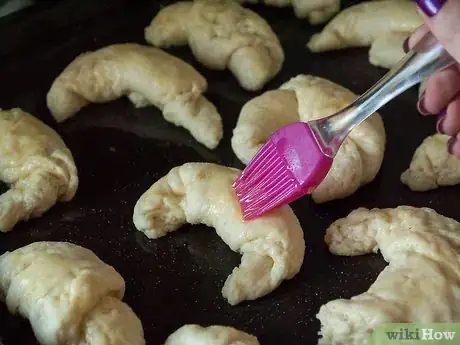This article was co-authored by Quynh La. Quynh La is a Professional Baker and the Owner of Sugar Bakery & Cafe in Seattle, Washington. With over seven years of experience, she specializes in baking cakes, cookies, croissants, and bread. Quynh holds an AAS in Culinary Arts from South Seattle College and a second AAS in Specialty Desserts & Bread from Seattle Central College.
wikiHow marks an article as reader-approved once it receives enough positive feedback. In this case, 86% of readers who voted found the article helpful, earning it our reader-approved status.
This article has been viewed 647,086 times.
These buttery and flaky French breakfast treats take a long time to prepare from scratch, but they're irresistible. The time and effort required to make them will temper your desire to gobble them up, and you'll never want the factory-made stuff again.
Ingredients
Servings: 8 croissants
- 1 1/4 teaspoons dry active yeast
- 3 tablespoons warm water
- 1 teaspoon sugar
- 1 3/4 cups (220g) flour
- 1 1/2 teaspoons salt
- 1/2 cup (120 ml) milk
- 2 tablespoons vegetable or grapeseed oil
- 1/2 cup (115g) unsalted butter, chilled
- 1 egg, for egg wash
Steps
Making the Dough
-
1Mix the dough. Mix the warm water, sugar, salt and yeast in a bowl, and let it sit for 5 to 10 minutes, until it foams and bubbles. Warm the milk in a pan on the stove, or in 5-second intervals in the microwave. Place the flour, warm milk, yeast mixture and oil in a bowl, and mix together.
- You can use a stand mixer or mix the ingredients by hand with a spatula.
- Be sure the milk doesn't come to a boil when you warm it. If it does, start over with new milk.
-
2Knead the dough. If you're using a stand mixer, you can simply let it continue to do the work for you for a minute or two after the ingredients are combined. If you're kneading by hand, punch out the dough 8 to 10 times. It should feel smooth and elastic when you're done.Advertisement
-
3Let the dough rise. Place the dough into a clean bowl dusted with flour. The flour will make it easier to remove the dough from the bowl later. Cover the bowl with plastic wrap or a dish towel. Allow the dough to rise for one to two hours. When it's doubled in size, you'll be ready for the next step.
- You can snip an X into the top of the dough to help the dough rise a little more quickly. Cut an X that's about 2 inches (5 cm) wide in the middle of the dough.
- Place the dough in a warm area in your kitchen to help it rise faster.
-
4Press the dough. After the dough has doubled, gently remove it from the bowl and place it on a countertop lightly dusted with flour.[1] Press the dough into an 8x12-inch rectangle (20x30 cm). Try to keep the edges as straight as possible. You can use your hands, or gently press down with a rolling pin.
-
5Turn the dough. Fold the dough into thirds, like a letter. This is called "turning." Fold up the bottom third of the dough so that it covers the middle third, then fold the top third down over the other two layers.
-
6Let the dough rise a second time. Cover the dough lightly with plastic wrap or a dish towel. Let it rise until it doubles in size again, which should take about an hour and a half. Put it in the refrigerator for the last half-hour, since it needs to be chilled for the next step.
- If you'd like, you can allow the dough to rise overnight in the refrigerator. Just put it in the fridge, and it'll be ready to go in the morning.
Making the Butter Layers
-
1Roll the butter. Line the countertop with a large piece of wax paper. Put the chilled butter on the wax paper, and fold the end of the paper over the top. Use a rolling pin to roll the butter between the sheets of wax paper, into a 12x6-inch rectangle (30x15cm).[2] Pound the stick a few times with the rolling pin to flatten it, then roll it out quickly into the rectangle. Try to work fast so the butter won't get too warm.
- An important thing to keep in mind throughout this process is that you never want the butter to melt until you place it in the oven. Try to prevent it from ever getting warmer than room temperature. Place it back in the refrigerator when necessary.[3]
- It helps to chill your hands and kitchen equipment so you don't warm up the butter. Wash your hands with cold water, and work with cooking instruments that have been chilling in the refrigerator. Make sure your kitchen isn't too warm, too.
-
2Lay the butter on the dough. Get the dough out of the fridge, and flatten it into a 14x8 inches (35x20 cm) rectangle. Place the rectangle of butter in the center of the rectangle of dough, lining it up so that it is at least a half-inch away from the edge of the dough.
-
3Turn the dough. Fold up the bottom third of the dough to cover the middle third, and the top third down to cover both layers, like you'd fold a letter. Make sure the butter is evenly layered and folded up with the dough.
-
4Roll the dough. Rotate the rectangle of dough 90 degrees, so that the short side of the rectangle is facing you. Roll the dough into a 14x8-inch rectangle (35x20 cm). This is the most important part of the process, and the trickiest one for most people to grasp: you're not rolling the butter into the dough. Instead, you're rolling out the dough and the butter so that the layers are ultra thin.
- If the previous steps took you awhile and the butter was starting to look a little soft when you put it into the dough, consider chilling the dough for 15 to 20 minutes before rolling it out in this step. Remember, you want the butter to stay cold and in thin little layers within the dough; you don't want it to melt or become part of the dough.
-
5Turn the dough again. Just as you did before, fold the dough like a letter, into thirds.
-
6Chill the dough. Wrap the dough in plastic wrap or wax paper, and place it in the refrigerator. Let it sit for 2 hours.
-
7Unwrap the dough and place it on a lightly floured surface. Tap it gently with your rolling pin a few times to deflate it. Place it so that the top and bottom sides are short, and the right and left sides are long. Allow the dough to rest for 8 to 10 minutes.
-
8Roll and turn the dough twice more. Roll out the dough into a 14x8 inches (35x20 cm) rectangle. Again, be careful not to press too hard — you don't want to crush the layers, just thin them out. Turn the dough again (folding it into thirds, like a letter). Now rotate the rectangle so that the short side is facing you. Roll it out into another 14x8-inch rectangle (35x20 cm). Fold it into thirds a final time.
-
9Chill the dough. Wrap it in plastic wrap or wax paper again. Let the dough chill in the refrigerator for two more hours. You can leave it overnight if you wish, as long as you put something heavy on top to prevent it from rising.
Cutting the Croissants
-
1Prepare for cutting. Lightly butter the baking sheet you plan to use. Lay a piece of wax paper over a second baking sheet. Dust the countertop with flour. Remove the dough from the refrigerator, and let it rest on the countertop for 10 minutes. Finally, roll the dough into a 20x5-inch rectangle (50x12 cm).
-
2Cut the dough lengthwise. Use a pizza cutter or a knife to cut the dough in half lengthwise. You should end up with two 10x5-inch (25x12 cm) pieces of dough. Place one piece of dough on the baking sheet covered in wax paper. Put another layer of wax paper on top.
-
3Cut the second piece of dough into three 5x5-inch squares (12x12 cm). Make two width-wise cuts on the strip of dough. Place two of the squares on the wax paper baking sheet. There should be a layer of wax paper separating them from your larger rectangle of dough. Put the baking sheet in the fridge to keep the butter chilled.
-
4Diagonally cut the remaining square of dough in half. You'll end up with two triangles, which will become your croissants.
-
5Roll a dough triangle into a croissant. Starting at the widest side, roll the dough upward to the top of the triangle. Form it into a crescent, and place it on the buttered baking sheet so that the top of the triangle is pinned to the sheet by the croissant. Repeat with the second dough triangle.
-
6Finish making croissants. Remove another dough square from the refrigerator. Repeat the cutting and rolling process. Continue removing squares from the refrigerator, cutting them into triangles, and rolling the triangles into croissants until you run out of dough. You should end up with 8 croissants on your buttered baking sheet.
-
7Let the croissants rise. Cover the baking sheet loosely with a clean dishtowel, and allow the croissants to rise for an hour.
Baking the Croissants
-
1Preheat the oven to 475°F (240°C).
-
2Make the egg wash. Break the egg into a small bowl, and use a fork to mix it up with 1 teaspoon of water.
-
3Brush the egg wash over the tops of the croissants.
-
4Bake the croissants for 12 to 15 minutes. They should be golden brown on top when they're done.
-
5Serve the croissants. Remove the croissants from the oven, and let them cool for 10 minutes on a baking rack. Try to resist the urge to eat them immediately — they'll be hot!
Expert Q&A
-
QuestionWhat is the trick to making a perfect croissant?
 Quynh LaQuynh La is a Professional Baker and the Owner of Sugar Bakery & Cafe in Seattle, Washington. With over seven years of experience, she specializes in baking cakes, cookies, croissants, and bread. Quynh holds an AAS in Culinary Arts from South Seattle College and a second AAS in Specialty Desserts & Bread from Seattle Central College.
Quynh LaQuynh La is a Professional Baker and the Owner of Sugar Bakery & Cafe in Seattle, Washington. With over seven years of experience, she specializes in baking cakes, cookies, croissants, and bread. Quynh holds an AAS in Culinary Arts from South Seattle College and a second AAS in Specialty Desserts & Bread from Seattle Central College.
Professional Baker Make sure that your butter is solid! You want to start the process by cutting small pieces of butter and putting them together to become a rectangle of square-shaped butter blocks. Once you have it made, stick the butter block in the fridge and chill it until it's not too hard, but not too soft. Ideally, your finger should easily be able to make an imprint on the butter.
Make sure that your butter is solid! You want to start the process by cutting small pieces of butter and putting them together to become a rectangle of square-shaped butter blocks. Once you have it made, stick the butter block in the fridge and chill it until it's not too hard, but not too soft. Ideally, your finger should easily be able to make an imprint on the butter. -
QuestionOn which rack am I supposed to put the baking tray?
 MrExpertCommunity AnswerPut in the middle if you have three racks. If only two, move your top rack to the middle and put there.
MrExpertCommunity AnswerPut in the middle if you have three racks. If only two, move your top rack to the middle and put there. -
QuestionWhy does the butter burst out when I'm rolling the dough?
 Community AnswerIf the butter is bursting and tearing out of the dough, then that means it's not soft enough to be rolled,
Community AnswerIf the butter is bursting and tearing out of the dough, then that means it's not soft enough to be rolled,
Things You'll Need
- Rolling pin
- Plastic wrap or wax paper
- Pizza cutter or knife
- 2 baking sheets
- Bowl
- Dish towel
- Brush
- Stand mixer (optional)
References
About This Article
To make croissants, let the dough rise for 1-2 hours, roll it out, fold it into thirds, and let it rise again. After that, roll the dough out a second time, top it with a layer of butter, and fold it in. You should repeat that process of rolling and folding the dough multiple times before chilling it and rolling it out a final time. Then, cut the dough into triangles, roll them into croissants, let them rise, and bake them at 475°F for 12-15 minutes. For tips on rolling the dough for better texture, and to learn how to use an egg wash, scroll down . . .


